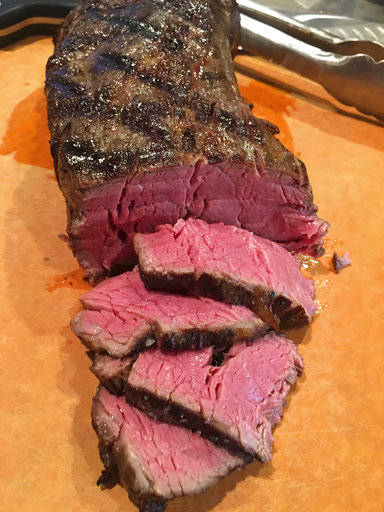If you are a meat geek, then you have read about the reverse sear, which has gained popularity in the grilling and barbecue world in the past few years. Reverse-sear is a technique where you cook the meat slowly using a low indirect heat and when it is almost done, you sear it over a high direct heat to brown the outside.
I practiced the “reverse-sear” for larger pieces of meat such as a beef tenderloin that I smoked the day before and seared or charred just before serving. This is my favorite way to cook a tenderloin, but it assumes that you have a smoker. I tried to reverse sear a steak like all the reverse-sear advocates by cooking the steak by indirect heat on a grill and then searing it over high direct heat at the end of the cooking time, but I never got a good sear on my steak so I abandoned the idea of reverse sear for a grilled steak. I sear my steaks over direct heat first and then finish cooking them over indirect heat (I call that the combo method) because I get better grill marks and more smoky caramelization and they taste better. I never bought into the searing keeps the juices in, because the only thing that keeps the meat juicy is oiling the food to create a barrier so the natural juices won’t evaporate during the cooking time.
However, as an advocate of indirect cooking, I know why cooking meat with indirect heat gives you superior results. So, I decided to re-visit the sous vide circulator. When I first experimented with sous vide, it was a clumsy process that required vacuum-sealed meat, a large plastic container and various clamps to keep the circulator upright.
That has all changed since the Joule circulator has been introduced. The Joule is magnetic, and so small that it fits easily in your drawer — it is shorter than an immersion blender and even easier to use. I tested a center-cut piece of tenderloin (a.k.a. chateaubriand). I prepped it simply with a light coating of olive oil, and a sprinkle of coarse sea salt, dehydrated garlic and rosemary. I didn’t have a vacuum sealer so I put it in a re-closeable freezer bag, pushed out the excess air with my hand, and clipped it to the side of a stock pot with a chip clip. I filled the pot up about halfway with warm water, slipped the circulator in the water and let the bottom magnet secure it, and turned it on using the handy phone app.
Two hours later, the tenderloin was cooked to a perfect rare. I removed it from the water, and let it cool to room temperature. A few hours later, I removed it from the bag and gave it a little pat with a paper towel to remove any excess surface moisture. Next, a light brushing of oil to prevent stickage and seal in the juices, and I took it to the grill. I seared it over a high direct heat for 1-2 minutes on all sides, making crosshatch marks on the top and bottom and the two sides. You must do this with the lid down so that you get really good grill marks and it has a chance to warm the center of the tenderloin. The total cooking time is about 6 minutes depending on the size of your tenderloin.
Once you have seared/charred the sides, let it rest for 3-5 minutes and carve into thin slices. The meat will be mouthwateringly delicious, tender, juicy and may be the best tenderloin that you have ever made. This is the ultimate reverse sear and worth the extra step.
The Ultimate Reverse Sear Beef Tenderloin
Servings: 8-10
Active Cooking Time: 25 minutes (Sous Vide: 2-3 hours at 140 F)
2-3 pounds whole trimmed center-cut beef tenderloin
4 tablespoons Extra-virgin olive oil, divided
1 tablespoon coarse pink or coarse white sea salt
1/2 teaspoon dried rosemary
1/2 teaspoon granulated garlic
Wrap beef tenderloin in paper towels to remove surface moisture. Mix salt, spices and olive oil into a paste. Rub tenderloin all over with oil-salt paste.
Place tenderloin in the center of a large re-closable freezer bag. Remove the air and clip the bag to the side of a stockpot with a chip clip or clamp. Fill Stockpot with warm water and insert circulator. Set Circulator at 140 F for 2-3 hours depending on the doneness you like and the size of your tenderloin. The smaller, the shorter the time. Let cook until your desired doneness is reached. The Joule app can walk you through this process.
Remove from water and let cool. If doing ahead, refrigerate overnight. Otherwise, let cool to room temperature and set aside until ready to eat. Just before serving, pre-heat a grill with all burners on high for 15 minutes. Clean cooking grates with a brass-bristle brush. Remove tenderloin from the refrigerator and dab with paper towels to remove any moisture. Brush lightly with olive oil. Using 12-inch tongs, sear/char all the sides of the tenderloin by searing and turning, about 1-2 minutes per side — as if the tenderloin has four sides. If you like the look of crosshatch, you can do that as well. Total searing time on all sides should be about 6 minutes.
After all the sides are seared, take off and let sit 3-5 minutes. Slice thinly and serve your favorite sides.
Nutrition information per serving: 202 calories; 106 calories from fat; 12 g fat (4 g saturated; 0 g trans fats); 66 mg cholesterol; 497 mg sodium; 0 g carbohydrate; 0 g fiber; 0 g sugar; 24 g protein.
Elizabeth Karmel is a barbecue and Southern foods expert. She is the chef and pit master at online retailer CarolinaCueToGo.com and the author of three books, including “Taming the Flame.”

